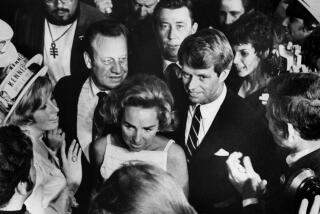From the Archives: Criticâs Notebook: JFK was arts patron in chief
Three days after Lee Harvey Oswaldâs bullet inconsolably blackened the mood of America, Leonard Bernstein tried to lift the nationâs spirits by focusing on a special legacy â one that is getting too little attention in the commentary around Fridayâs 50th anniversary of the assassination of John F. Kennedy.
Instead of performing a requiem Mass for a slain Roman Catholic president, Bernstein led the New York Philharmonic in Mahlerâs Second Symphony, known as the âResurrection.â JFK had, like no president before him, empowered artists, and that was expected to last.
âAmerican artists have for three years looked to the White House with unaccustomed confidence and warmth,â Bernstein said that day. âWe loved him for the honor in which he held art, in which he held every creative impulse of the human mind, whether it was expressed in words, or notes, or paints, or mathematical symbols.â
PHOTOS: JFK assassination at 50: Museum exhibits
Taking advantage of artists to inspire national optimism, the Kennedy White House made art glamorous. In return, art became a crucial factor in the new Camelot.
But it is hardly surprising that this aspect of the Kennedy administration is being overlooked.
Despite an unprecedented explosion of the arts in America over the last half-century, artists have never again been afforded such national prominence.
Washington has become so nervous about and impervious toward art that it seems like fantasy to recall a moment in this country when artists powerfully influenced how Americans felt about America, its identity and future.
That, in turn, fueled the support for great deeds. It wasnât merely the advances in cold science that convinced the public we could go to the moon. This was also a poetic project, and that is how it was persuasively presented, as part of the pulse of America then. A desire to recapture something of the lost optimism after JFKâs assassination even helped allow Lyndon Johnson to put forward his proposal for a Great Society.
Art was there from the beginning for the Kennedy administration. The great, barrier-breaking, African American contralto Marian Anderson sang at the inauguration. My favorite photo of the Kennedy era is a picture of Bernstein and Frank Sinatra backstage at an inaugural ball as they waited to go on, each trying to appear cooler than the other and each looking like he had just been given the keys to the country.
PHOTOS: John F. Kennedy on screen
John Steinbeck, W.H. Auden and Robert Lowell were on hand. In all, the president â no doubt at the urging of the first lady, Jacqueline Kennedy â invited 50 writers and artists and musicians to the inauguration.
I happen to have been among the millions of impressionable American teenagers the Kennedys helped turn on to the arts.
A few months before the assassination, I remember seeing JFK on the evening news at the opening of a National Gallery Leonardo da Vinci show. He attended with the French minister for cultural affairs, who was a novelist and art theorist. That got me, and many other students at my high school in Pasadena, not only fascinated with Da Vinci but also reading AndrĂŠ Malraux. When since has a president dared pose with a leading public intellectual?
PHOTOS: How TV reacted to JFKâs assassination
Many years later, I met Jackie when she was a book editor in New York, and thanked her for her contribution to American culture as first lady. She said she was sorry she hadnât done even more, especially for the explosion of experimentation that was happening in American art in the early â60s. I joked whether this meant she might have had a Happening at the White House. She smiled, and said, in all seriousness, âPerhaps.â
She was clearly the one behind the scenes making art a matter of public discussion, but the president played the gracious host, and that is all that mattered. Classical musicians especially loved him for it. Bernstein treated the White House as a second home. Aaron Copland was always welcome. The revered cellist Pablo Casals was accorded the kind of reception that the pope would typically get.
âI know of no musician in this country who did not love John F. Kennedy,â Bernstein said at the 1963 memorial concert.
Yes, the arts have flourished in America since. Performing arts centers and museums have been built by the hundreds. The National Endowment for the Arts was established under Johnson in 1965, thanks to the Kennedy legacy. But with Vietnam raging, artists hated LBJ. These days, we all know what a political liability supporting the NEA has become for any national politician.
Barack Obama started out with an arts agenda. He too had classical musicians at his first inauguration and has invited artists to the White House. But neither he nor any other president has come close to giving art and artists the kind of visibility that JFK did.
At the beginning of this year, I suggested President Obama might consider cashing in some of his political capital from his landslide election and create a Cabinet post for secretary of Culture, something thatâs common in governments in much of the world.
Instead, he spent the capital elsewhere and has little to show for it. Meanwhile, the inspirational optimism of the Camelot years feels all but irretrievable. Those two facts may not be unrelated. This country has never needed its artists more.
More to Read
The biggest entertainment stories
Get our big stories about Hollywood, film, television, music, arts, culture and more right in your inbox as soon as they publish.
You may occasionally receive promotional content from the Los Angeles Times.











